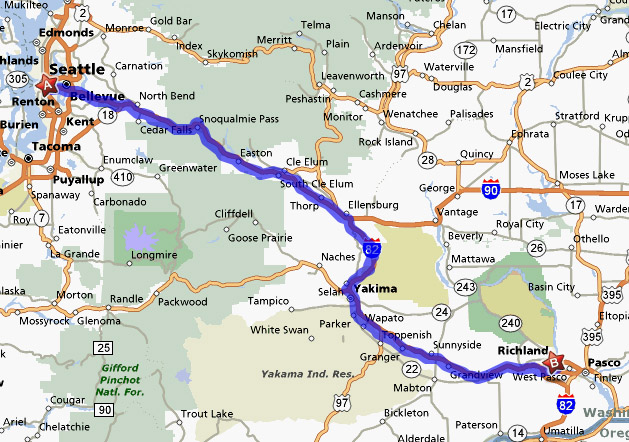Getting to Hanford, and the B reactor
Hanford sits in the south eastern
corner of Washington State, and is not close to anything else. This was part of
the reason for its selection. Of course, the area has grown quite a bit, since
the days of the Manhattan Project. The Tri-Cities area, as it is now called,
contains several hundred thousand people, and is one of the major urban areas of
the state. Still, to get there can be a chore. The local airport is just that -
a local airport. It is served by local shuttles and air taxis; but you are
unlikely to find a major airline serving here. Generally, the visitor who does
not live in the area, will fly or take a train into Seattle or Spokane, and
drive the rest of the way. From Seattle it is about a three and a half hour drive, passing over the Cascade range, and then entering the arid lands in the rain shadow of the mountains. The
 trip from Tacoma is about the same, at 233 miles, with a somewhat less
interesting drive. There is bus service available to Pasco, though not directly
to Richland. The drive from Seattle is interesting in the variety of terrain
covered.
trip from Tacoma is about the same, at 233 miles, with a somewhat less
interesting drive. There is bus service available to Pasco, though not directly
to Richland. The drive from Seattle is interesting in the variety of terrain
covered. The coastal area seems a bit like paradise on earth, it is lush, and beautiful. There is rain and an abundance of flora and fauna. In the background are the mountains, and the sea. The nearby farmlands produce abundant food, as do the fisheries. The heavily forested areas once supported a booming lumber industry.
Much of this heavy forest is in the surrounding mountains. These, too, seem like paradise on Earth, and climb rapidly from the sea. having crossed the mountains, the traveler arrives at a comparatively arid series of valleys, carved onto a high and dry plain. In a sense it appears that the state of Washington is averaging the lush rain soaked coast, with the dry and less hospitable interior. So in Washington, everything would seem to even out, except for the topography, which is nowhere flat.
I saw no trees in eastern Washington, except for those planted and watered in the cities. The countryside was brown, arid, and pretty much a desert, complete with cacti. The treeless plain is known for the winds which can race across the land. Still, in its own way it is quite scenic, and open, and seems to echo the call of the
A twenty minute drive from the mountains takes the traveler to quite a different place. Desert and high plains, like something out of an old west movie. Gone are the trees of moments ago, to be replaced by the cacti and short scrub of a surprisingly expansive desert which trickles down Idaho into Utah and Nevada. Only a few small towns, the occasional road stop, and intermittent car traffic interrupt the traveler lost in thought, and admiration for the scenery. Upon arrival, I got to check into my hotel, right off the freeway and not far from downtown. Richland, Pasco, and Kennewick are great places, and my tours of Hanford were fascinating, and I enjoyed my visit there greatly; but there is a certain sameness about all of the places that we develop and civilize. There is nothing like a drive through a fairly desolate area, to make one feel individualistic, free, and able to do anything, and overcome all obstacles. It may be this factor that makes the classic road trip such an iconic and worthwhile experience. Life, they often say, is a journey - not a destination.